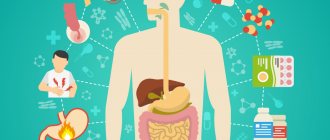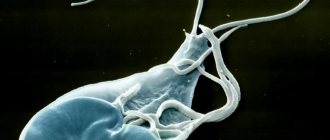Intestinal flu got its name due to the characteristics of its symptoms.
The disease is caused by rotavirus infection and at the initial stage resembles a cold: the patient develops catarrhal symptoms on the mucous membranes of the nasopharynx and oropharynx, pain in the larynx, nasal discharge, and body temperature rises. On days 2-3, inflammation of the mucous membranes of the gastrointestinal tract occurs, and the signs of the disease resemble the clinical picture of digestive disorders.
One of the manifestations of intestinal flu is viral gastroenteritis - a pathological inflammatory process that occurs in the lining of the small intestine and stomach.
General information
Intestinal flu is often called rotavirus infection , a disease caused by rotaviruses . Also in everyday life you can often hear the names stomach flu, abdominal flu, although in fact the disease is not related to influenza . It is this disease that most often causes diarrhea in children, also causing other symptoms of gastrointestinal distress. The disease begins acutely, affecting the mucous membrane of the stomach and intestines. According to medical statistics, approximately 95% of children suffer from intestinal flu before the age of 5 years. As a rule, the child’s immune system is able to cope with the virus. However, for infants and small children this condition can be dangerous, since severe viral diarrhea leads to dehydration and the subsequent development of a dangerous condition - hypovolemic shock . Parents should be aware that if there is severe vomiting and diarrhea, the infant may become dehydrated within six hours of the onset of symptoms. That is why it is important to clearly know how the stomach flu is transmitted and manifested, as well as what to do if a child shows signs of this disease.
Pathogen
The causative agent of this disease is rotaviruses belonging to the family Reoviridae and the genus Orbiviruses. Rotavirus was first discovered by scientists in 1973. Since it has a ring structure, it was called “rotavirus” (from the Latin word for “wheel”). Rotaviruses are divided into seven serogroups (A, B, C, D, E, F, G). Viruses belonging to serogroups A, B, and C are pathogenic for humans.
In more than 90% of cases, the causative agent of the disease is rotavirus A. According to statistics, about 25 million cases of the disease are diagnosed every year in the world. At the same time, 600-900 thousand cases end in death.
Rotavirus is the main cause of severe diarrhea in children and infants. Rotavirus infection now accounts for 50% of cases of diarrhea, which requires hospitalization. Boys are hospitalized twice as often as girls.
Both sporadic cases of the disease and its epidemic outbreaks are recorded. Such outbreaks often occur in kindergartens, orphanages, medical institutions for children, etc. The incidence is higher in the cold season.
Rotavirus B is also called adult diarrhea rotavirus. There have been a number of epidemics in the world that were caused by this particular type of virus.
As for how this virus is transmitted, its main mechanism of transmission is fecal-oral. Rotavirus virions are well preserved in the environment. They tolerate low temperatures well. In the external environment, the pathogen is stable and can remain viable from 2 weeks to 1 month. The virus persists in feces for up to 7 months. The virus can survive on products for 1-2 months.
Statistics show that in countries with low and high levels of healthcare, the incidence of intestinal influenza is approximately the same, which confirms the ineffectiveness of sanitary measures against rotavirus.
What it is?
In simple words, intestinal or stomach flu is an infectious disease caused by rotaviruses.
The disease manifests itself as intestinal and respiratory syndromes. Intestinal pathogens are viruses of the Reoviridae family, which are similar in antigenic structure. When viewed under a microscope, they resemble wheels, with a clear rim and short spokes. This viral pathology began to be studied in the early 70s of the last century, when they were discovered in the mucous membrane of the small intestine of sick children.
Pathogenesis
When rotaviruses enter the gastrointestinal tract, they penetrate the intestinal mucosa and infect it. Viruses are resistant to proteolytic enzymes and bile, so after entering the body they reach the epithelium of the small intestine and penetrate into highly differentiated cells of the villi. Under the influence of rotavirus, the absorption and transport functions of the intestine are disrupted. The virus affects protein synthesis, causing the affected cells to produce new viral particles. As a result, the infected cell dies, resulting in the release of many infected particles. After this, the cycle repeats again, and the death of mucosal cells progresses.
The consequence of this is intestinal inflammation. There is a deficiency of enzymes, resulting in impaired digestive function. Due to disruption of the enzymatic systems of enterocytes, which break down carbohydrates, in particular lactose, secondary lactase deficiency develops. Due to the accumulation of excess non-hydrolyzed carbohydrates, the osmotic pressure in the colon increases and the reabsorption of water and electrolytes is disrupted. Fermentation of unsplit disaccharides by intestinal microflora leads to the formation of large amounts of organic acids, carbon dioxide, hydrogen, and water. All this leads to the fact that the pH of the intestinal contents decreases and gas formation increases.
The main symptom of the disease, profuse diarrhea, develops due to the fact that fluid absorption is impaired under the influence of enterotoxin. Intoxication of the body increases, this causes a significant disturbance in the water-electrolyte balance. If the necessary measures are not taken in time, dehydration , the volume of circulating blood decreases, which can subsequently lead to hypovolemic shock .
The development of an imbalance of intestinal microflora is important in the pathogenesis of rotavirus infection. In children, the enzymatic and barrier systems of the gastrointestinal tract are imperfect, so the intestinal microbiocenosis is disrupted. Colonization of the intestinal mucosa by opportunistic microorganisms is noted.
Risk factors
For the development of gastroenteritis, it is important not only for the virus to enter the intestines, but also other factors. The reproduction and activity of infection are greatly influenced by:
- state of local (intestinal) and general immunity;
- presence of other diseases;
- age;
- level of natural interferon in cells;
- acidity of gastric juice;
- resistance of villi of the small intestinal epithelium;
- enterocyte permeability.
The more risk factors present at the time of infection, the lower the concentration of the virus that can cause disease. The more weakened the body is (stress, other infections, immunodeficiencies), the more severe rotavirus gastroenteritis will be.
Classification
Despite the fact that there is no generally accepted clinical classification, in medical practice several types of rotavirus infection are distinguished, taking into account the severity of the course, etc.
Depending on the characteristics of the manifestations, the following forms are determined:
- Typical - proceed as gastritis , enteritis , gastroenteritis .
- Atypical – a mild asymptomatic course is noted.
- Virus carriage.
According to the severity of the disease, depending on the severity of symptoms and the degree of damage to the gastrointestinal tract, the following forms of the disease are distinguished:
- Mild - symptoms are moderate, pain and intoxication are mild, diarrhea - up to 5 times a day.
- Moderate - the temperature rises to 39.5°C, symptoms of intoxication are pronounced, the frequency of stools is up to 18 times a day. The pain syndrome is pronounced.
- Severe – intoxication is pronounced and severe. The temperature rises to 40°C. Repeated vomiting, watery stools up to 25 times a day.
Depending on the duration of the disease, the following forms are distinguished:
- Spicy.
- Lingering.
- Chronic.
Causes
The source of infection is a sick person or a virus carrier who excretes the pathogen in feces. Since intestinal flu is a predominantly childhood disease, children are the source of infection. The primary source of infection is those children who attend organized children's groups. The route of transmission of the virus is fecal-oral. Children under three years of age are most susceptible to infection. Also at risk are older people with chronic diseases. Immunity to infection is short-lived.
You can become infected with rotavirus in the following cases:
- When swimming in bodies of water where wastewater is discharged.
- If the pathogen enters the central water supply system, after which such water is used for washing, cooking, etc.
- Contact with a sick person or a virus carrier.
- Consumption of contaminated products.
- Infection inside health care facilities.
How to prevent infection
Treating rotavirus at home is not a difficult task if you adhere to the correct diet, drinking regimen and take medications recommended by your doctor. It is important to avoid infecting household members. The virus is transmitted through shared objects and utensils. An adult can tolerate the disease relatively easily, but for a child’s body, infection can be a serious challenge.
Maintaining strict personal hygiene is a rule that must be followed if there is a patient with rotavirus in the house. The infected person should be isolated in a separate room and given an individual set of dishes. After each meal, the patient’s plate, cutlery, and cup must be washed and disinfected.
Bed linen, underwear, and towels of a sick person should be changed daily and boiled. After drying, the linen is ironed with a hot iron and steam.
Medical mask
The person caring for the sick must protect himself. You must wear a mask when communicating. Washing dishes and changing linen should be done with gloves.
The apartment must be wet cleaned twice a day. Surfaces must be wiped with water with the addition of a disinfectant (add 50 ml of whiteness per 5 liters of liquid). Airing the room of a patient with intestinal flu is carried out every hour, lasting at least 10-15 minutes.
Note! Infection with intestinal flu can be avoided by washing your hands frequently and thoroughly after visiting public places or the toilet. Care must be taken when processing products. After purchase, fruits and vegetables should be washed under the tap, then rinsed with a solution of 1 liter of water with apple cider vinegar (100 ml).
Symptoms of intestinal flu
Since the disease is cyclical, the symptoms depend on the period of the disease.
The following periods of stomach flu are distinguished:
- incubation – 1-5 days;
- acute – 3-7 days, in severe cases – more than 7 days;
- recovery period is 4-5 days.
Symptoms of intestinal flu in children are acute. In the acute period, vomiting is observed, body temperature rises sharply, and abdominal pain is bothersome. Diarrhea develops, and the stool is characteristic: starting from the second day of illness, it acquires a grayish-yellow hue and a clay-like consistency. During this period, feces and urine have signs similar to those of hepatitis: urine is dark and may contain flakes of blood, feces are light.
In the acute period, there is a pronounced loss of strength and lack of appetite. Other signs often appear in adults and children. There may be a runny nose, sore throat when swallowing, and redness of the throat. Alarming symptoms in children are signs of dehydration.
Symptoms of intestinal flu in adults may not be as severe. Sometimes those infected do not realize that they are sick, feeling only a slight malaise and noting very mild symptoms.
Most often, the disease lasts 1-2 weeks. Full recovery from illness takes several weeks, during which those who have recovered feel weak and have poor appetite.
Thus, with intestinal flu the following groups of symptoms appear:
- General infectious syndrome - the temperature rises, usually to febrile levels. There are signs of general intoxication .
- Syndrome of local changes - vomiting, diarrhea. The stool is watery, profuse, foamy, and may contain mucus. Diarrhea lasts 3-7 days, sometimes longer. In infants, diarrhea is most often combined with flatulence .
- Abdominal pain syndrome - pain can be localized in the upper abdomen or be diffuse. Attacks of cramping pain are possible.
- Dehydration syndrome – in the process of vomiting and diarrhea, the patient loses fluid.
- Syndrome of catarrhal changes - catarrhal phenomena from the upper respiratory tract are noted.
Mechanism of disease development
The virus enters the human oral cavity with contaminated food, water, dirty hands or droplets of saliva during aerogenic transmission and is swallowed by him. Virions are resistant to acids, so they easily overcome the acidic environment of the stomach and enter the duodenum. The main function of the duodenum and the small intestine as a whole is the enzymatic breakdown of nutrients into the smallest components and their further absorption into the blood.
Diagram of the gastrointestinal tract
The area of this section of the gastrointestinal tract is colossal: the small intestine is about 5 meters long and is dotted with villi - outgrowths of the mucous membrane - over its entire surface. Blood vessels enter each villus from the side of the intestinal wall - nutrients are absorbed into them. On the side of the intestinal cavity, villi are covered with special epithelial cells - enterocytes. Enterocytes have an elongated shape and at the pole facing the intestinal lumen they, in turn, have outgrowths of the cell membrane in the form of microvilli. Thus, the absorption area of the intestine is additionally increased by 30 times.
Intestinal influenza viruses penetrate enterocytes, shed their protein coat and send their hereditary information (DNA or RNA) to the cell nucleus. The synthesis of viral proteins is launched and this process completely suppresses all other cellular processes. As a result, a huge number of virion components accumulate in the enterocyte, they are further assembled and released into the external environment. Viral particles rupture the cell membrane, which leads to the final death of the cell.
Massive infection of neighboring cells occurs, they die and are sloughed off from the main villous graft. As a result, the processes of cell-cell digestion, the breakdown of oligosaccharides into monosaccharides and their absorption are disrupted. Carbohydrates accumulate in the intestinal lumen, increasing the osmotic pressure of chyme - a paste of partially digested food. An increased concentration of oligosaccharides leads to a compensatory entry of water into the intestinal cavity in order to dilute the chyme and normalize its osmotic pressure. A large volume of liquid contents in the intestinal lumen irritates the nerve endings in its wall and a reflex increase in peristalsis occurs.
As a result, the diluted chyme quickly passes through the entire intestinal tube, the excess liquid does not have time to be absorbed and diarrhea develops - copious loose stools. Overflow of the duodenum, in turn, disrupts the normal movement of the food bolus from the stomach. Antiperistaltic waves arise in the stomach and food finds its way out through the esophagus in the form of vomiting.
In response to cell death and virus replication, immune cells begin to produce protective antibodies. They bind viral particles, gradually clearing them from the infectious focus. Some of the virions come out along with the feces to continue their development cycle.
Tests and diagnostics
To establish a diagnosis, the doctor conducts a survey and examination, carefully analyzes the clinical picture.
To determine the rotavirus antigen, the following laboratory methods are used:
- Enzyme immunoassay is the main research method that allows you to determine rotavirus antigens in fecal samples.
- Polymerase chain reaction.
- Coagglutination reaction .
- Latex agglutination reaction.
- Complement fixation reaction.
- A general and biochemical blood test is also performed.
The following laboratory signs indicate a severe form of rotavirus infection:
- dehydration syndrome;
- electrolyte disorders in the blood;
- metabolic acidosis ;
- endogenous intoxication syndrome.
If necessary, other research methods are prescribed to determine the condition of other organs and systems.
Treatment with folk remedies
Parents must understand that any treatment with folk remedies is possible only if the diagnosis is confirmed, the child feels satisfactory, and folk treatment is practiced as an auxiliary method. In such cases, after consulting with your doctor, you can give your child herbal teas and dried fruit compote to replenish lost fluid. In severe cases of the disease, you should immediately contact a specialist and adhere to the prescribed treatment regimen. The following folk remedies are used:
- Blueberry compote, a decoction of dried blueberries, helps remove toxins from the body.
- Dill water - for its preparation 1 tsp. dill seeds should be poured with a glass of boiling water and left for an hour. Small children are given 1 tsp. of this product once every two hours. Preschoolers can drink half a glass of the product several times a day.
- Chamomile tea has anti-inflammatory properties. To prepare 1 tsp. dried flowers are poured with 1 cup of boiling water.
- Raspberry – helps relieve intoxication. You can prepare a decoction of raspberry leaves or a fruit drink of raspberry jam.
- Dried fruit compote - recommended during the recovery period.
Pathogenicity of intestinal viruses for animals and their reproduction in tissue cultures
Rhesus monkeys (Macaca mulatta), cynomolgus monkeys (Macaca irus), African green monkeys (Cercopithecus aethiops) and some other species highly susceptible to infection by poliovirus have served for many years as the only model for experiments with this virus. The introduction of tissue cultures into virological practice has made the use of monkeys unnecessary in the diagnosis of polio, but they are used to study the neurotropism of poliovirus strains, in particular when monitoring live poliovirus vaccine. All three types of poliovirus have been adapted to cotton rats, as well as adult and newborn white mice. Newborn white mice turned out to be sensitive to Coxsackie viruses and were used to isolate the first strains of the virus, and then to divide Coxsackie viruses into subgroups A and B according to characteristic pathological characteristics. Coxsackie A viruses cause generalized myositis; Coxsackie B viruses are characterized by dystrophic changes in the interscapular brown fat and focal myositis. The ability to infect nervous tissue is not a general property of Coxsackie viruses, however, the Coxsackie A7 virus can cause polio-like changes in the spinal cord of monkeys (M.K. Voroshilova, M.P. Chumakov, 1959), and the Coxsackie A16 virus can cause damage to neurons [Lu, Wenner (T. Lou, H. Wenner), 1962]. ECHO viruses do not cause significant disease in laboratory animals.
Substrate for isolating and studying K. v. are tissue cultures. Viruses multiply better in the epithelial cells of primates. Three types of poliovirus and all Coxsackie B viruses multiply in the cells of monkey kidneys, HeLa, and human amnion. The ability of Coxsackie A viruses to grow in cell cultures varies. Some Coxsackie A viruses can be isolated during primary infection of monkey kidney cells (A7, A9, A14, A16, A21), HeLa, HEp2, KV - primary or diploid cultures of human embryonic kidney cells. The remaining representatives of group A are isolated primarily during infection of newborn white mice. Coxsackie viruses A1, A5, A6, A19 and A22 are isolated and cultivated only on these animals. ECHO viruses reproduce well in cells of primary cultures of monkey kidney tissue (except for ECHO-21, which has the ability to reproduce in cultures of epithelial cells of human origin). Most representatives of this group K. v. capable of growth in cultures of human embryonic amnion and kidney cells and in diploid cells of the W1I-38 type, however, transplanted cells are less sensitive to ECHO viruses.
Rice. 1. Electron diffraction pattern of polio virus crystals (type I, Mahoney strain). Arrows indicate virus particles in the cytoplasm of the cell; X 14,000. Fig. 2. Vials with a single-layer culture of monkey kidney cells. Arrows indicate plaques formed by the polio virus (type II, strain P712, Ch, 2ab).
Reproduction K. v. in tissue cultures is accompanied by the development of a typical cytopathic effect. Infected cells are rounded, wrinkled, pyknosis is observed in the nuclei, and at the final stages of degeneration, the cells are destroyed and fall off the culture surface. The study of the cytopathic effect in stained preparations makes it possible to distinguish changes caused by human enteroviruses from changes caused by cardioviruses, reoviruses and adenoviruses. Electron microscopic examination of ultrathin sections of cells infected with K. v. can detect cytoplasmic crystals formed by densely packed virus particles (Fig. 1). Cytopathogenic K. v. in cell cultures under an agar coating they form the so-called. plaques are areas of destroyed cells, revealed by intravital staining of the culture layer with neutral red, which does not stain destroyed cells. Polioviruses form round plaques with a light center and clear boundaries (Fig. 2). Plaques formed by Coxsackie B viruses have more blurred boundaries. Coxsackievirus A9 forms plaques with a darkened center (the presence of living cells) and unclear boundaries. Morphology of plaques and different sensitivity of different cell cultures to K. v. may help in the preliminary identification of isolated strains.
Prevention of intestinal flu
Prevention of rotavirus infection consists of eliminating infection with the virus. To do this, you should adhere to generally accepted rules of hygiene and follow a number of recommendations:
- Drink and use only clean water for cooking.
- Wash products very thoroughly and treat them thermally.
- Do not buy products at spontaneous markets.
- Practice breastfeeding.
- Teach children the rules of hygiene and monitor their implementation.
If group diseases of rotavirus occur in children's institutions, quarantine measures are practiced. They last 5 days from the time when the last patient was isolated.
As an effective preventive measure, vaccination against rotavirus with a vaccine containing live attenuated rotavirus is practiced. Under its influence, the body produces antibodies that protect against rotavirus infection. After vaccination, immunity lasts for 3-4 years.
Intestinal flu in children
Most often, rotavirus infection is diagnosed in children aged 6 months to 4 years. This is due to the fact that at six months the baby switches to mixed feeding, and the risk of infection through domestic means increases. According to statistics, about 95% of children suffer from intestinal flu in the first 5 years of life.
It is important to note that with severe diarrhea and vomiting, infants lose fluid very quickly. With a loss of more than 10% of body weight due to fluid, severe dehydration develops, leading to convulsions , dysfunction of organs and systems, and coma . Such dehydration can develop within 6-12 hours after the first symptoms appear. Therefore, parents should not delay visiting a doctor.
It is especially important to provide emergency care to sick newborns and premature babies. Despite the fact that such babies rarely have manifest forms of rotavirus infection, when infected they very quickly develop dehydration, which increases the risk of an unfavorable outcome of the disease.
Diet
Diet No. 4a
- Efficacy: therapeutic effect after 3-5 days
- Time frame: 5 days
- Cost of products: 1250-1300 rubles per week
Diet No. 4b
- Efficacy: therapeutic effect after 10 days
- Duration: 2 weeks - 1 month
- Cost of products: 1300-1400 rubles per week
Diet for intestinal infections in children
- Efficacy: therapeutic effect after 10 days
- Terms: 1 month or more
- Cost of products: 1250-1350 rubles per week
The child’s nutritional characteristics depend on his age, the severity of the disease, the presence of concomitant diseases, etc.
- Infants should remain breastfed whenever possible.
- If the disease is mild , then the child’s daily nutritional intake is reduced by 15-20%. After 2-3 days, the volume is gradually restored.
- In moderate cases, the diet is reduced by 20-30%, while the child receives food in small portions up to 8 times a day. By 4-5 days the volume of nutrition is restored.
- In severe forms of the disease, the amount of nutrition is reduced by about half, it is gradually restored by 6-8 days. Meals are fractional, up to 10 times a day.
It is recommended that formula-fed children introduce adapted formulas into their diet, or those formulas that contain probiotics .
Older children need to be provided with a diet that is gentle on the gastrointestinal tract, for which the following recommendations should be followed:
- Exclude from the diet whole milk and products with coarse plant fiber (cabbage, beets, radishes, cucumbers, grapes, apricots, plums, legumes, nuts).
- Also, baked goods, pickles, smoked meats, canned food, fatty meat and fish should be excluded from the diet.
- Reduce the total amount of fat consumed.
- Food should be pureed, pureed, and served warm. It is recommended to prepare purees and puddings from vegetables: carrots, zucchini, potatoes, pumpkin. You can also prepare dairy-free porridges, steam cutlets from lean meat and fish.
- Fermented milk products are useful for children and adults during the period of treatment and recovery - cottage cheese, yoghurts, etc. If possible, you should choose yogurt and kefir with pre- or probiotics .
- You can include crackers, dryers, and savory cookies in your diet.
- Eggs can be included in the diet in the form of an omelet or hard-boiled.
- You can make jelly and compotes from fruits. The menu also includes baked apples and dried fruit compote.
If intestinal flu is diagnosed in adults, all of the above nutritional recommendations also remain relevant.
During the acute period of the disease in adults diet No. 4a ; during the recovery period, the patient is transferred to diet No. 4b , which should be followed for about a month.
Vaccination
The issue of vaccinations against gastroenteritis still remains extremely controversial. Ten years ago there was no vaccine for this disease, but work on its creation was carried out in many countries.
Only in 2009, a couple of stomach flu vaccines were introduced, which already at the first stage of mass use demonstrated fairly high-quality indicators. The collected vaccination statistics showed that the widespread use of stomach flu vaccinations can reduce the complexity of the disease, as well as reduce the number of cases of gastroenteritis, even among those who did not participate in the vaccination program. This effect was achieved by reducing the number of carriers of pathogens. Research into the effectiveness of the stomach flu vaccine was conducted in developing countries in Africa and Asia.
These results allowed the World Health Organization to issue a recommendation on the use of rotavirus vaccine for mass vaccination of children. But this practice is currently widespread only in certain countries.
Flu in adults: first symptoms and treatment Stomach ulcer: symptoms, treatment, diet, folk remedies ARVI: symptoms, prevention and treatment Bronchial asthma: symptoms, treatment, emergency care at home
Consequences and complications
The main complication of intestinal flu is dehydration, which most often occurs in sick children in the first years of life. You can recognize dehydration in babies by these first signs:
- restlessness and agitation;
- dry mucous membranes and skin;
- thirst;
- deterioration of skin elasticity;
- retraction of the large fontanel.
Gradually, excitement gives way to lethargy and lethargy. The baby refuses to drink, the breathing rate becomes higher, the volume of urine and the frequency of urination decreases. Urine has a pungent odor and is dark in color. If help is not provided in such a situation, the condition may threaten the child's life.
Complications of stomach flu can also include:
- addition of a bacterial infection;
- development of acute renal failure.
In adults, the disease usually occurs without complications. But in severe cases, they may also develop dehydration and dehydration shock.
In patients with immunodeficiency , the disease is severe. Complications of the disease may include hemorrhagic gastroenteritis or necrotizing enterocolitis .
Recovery Tips
Tips for children
To speed up recovery in infants or children with the stomach flu, you should:
- Continue breastfeeding your baby for as long as possible
- slowly start introducing solid foods to your children
Tips for adults
- avoid large meals
- rest as much as possible
- drink sports drinks and plenty of water
- eat easily digestible foods such as noodles, rice and oatmeal











